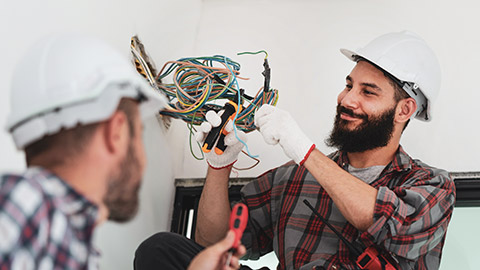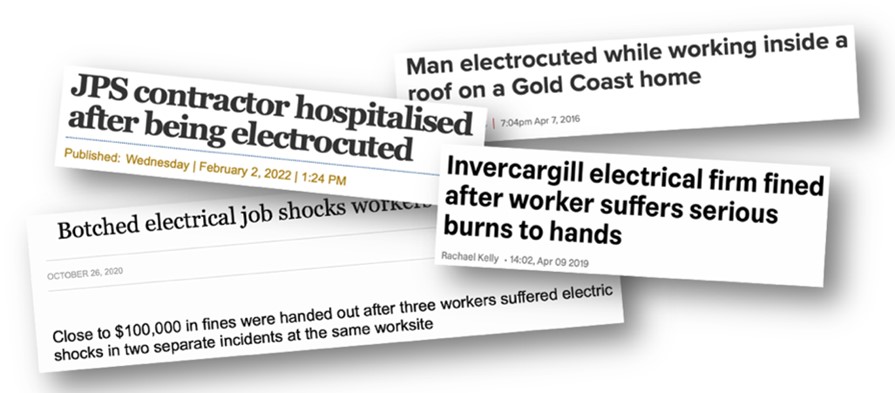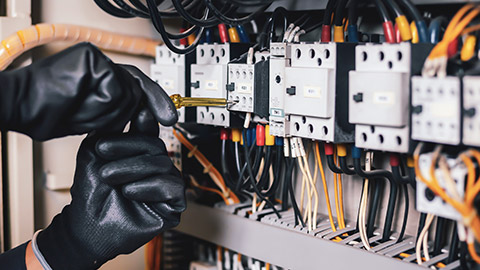Welcome to the first module of your Level 3 Certificate in Electrical Pre-Trade. This course covers the skills needed to kick-start a career in the electricity industry. Electricity is a serious workplace hazard and accidents can often be fatal, so the focus of this introductory course is safety: your safety; the safety of others; safe practices; and a safe environment.
In this module you will learn about safe procedures and practices and first aid in the electrical industry. You will gain knowledge of the electrical tools and equipment and about basic electrical tasks, earthing and equipotential bonding. You will gain a foundational understanding of legislations and standards regulating New Zealand electrical industry, and gain knowledge of the New Zealand electrical energy supply and distribution system. You will practice professional and ethical workplace behaviour. First Aid credits will be provided by an external provider.
During the face-to-face sessions of Module One you will practice safe testing for voltage, safe use of hand and power tools and learn about first aid in electrical workplace. You will also have the opportunity to carry out a risk management assessment. As part of this course, you will complete first aid training through an external provider.
This online self-paced resource contains learning content as well as self-directed learning (SDL). The SDL reinforces and clarifies what you cover in the lessons, plus it helps you to prepare for the assessments. Make sure you commit to putting in the extra hours required – the final result will be worth it.
Unleash your inner ELECTRICIAN!
| Credits | 24 |
| Learning Hours | 240 |
| Learning Outcome | LO 1.1 Apply safe procedures and practices when carrying out electrical tasks. LO 1.2 Provide first aid and CPR for a range of emergency situations in the electrical trade industry LO 1.3 Select and use hand and power tools and equipment commonly used in the electrical industry. LO 1.4 Perform a range of basic electrical tasks including earthing and equipotential bonding LO 1.5 Demonstrate introductory knowledge of electrical legislation and industry governance bodies. LO 1.6 Demonstrate knowledge of the New Zealand national electricity grid and associated electrical protection LO 1.7 Apply professional behaviours and complete basic documentation suitable for the electrical workplace |
| Assessment | ELE011A ELE011C ELE011D (The First Aid assessment 011B will be assessed by an external provider) |
You are free to plan your studies in the way that works best for you, but we know that guidance on how to do this is also helpful. We suggest following way to navigate through the learning content over the next few weeks:
| Week 1 | Topics One and Two |
| Week 2 | Topics Three and Four |
| Week 3 | Topic Four and Five |
| Week 4 | Topic Six |
| Week 5 | Topic Seven |
| Week 6 | Topic Eight |
| Week 7 | Topic Nine |

What we're covering:
- electrical industry career paths
- sharing your 'why'
- electrical terms glossary
Let’s get started!
There is a range of electrical trades available in New Zealand and the outlook for this career option is good due to the construction boom and a shortage of skilled electrical workers.
One of the most attractive reasons for joining the electrical trade is the number of career paths that the industry offers. Some of the roles you can choose from include:
- Electrical designer
- Electrical technician
- Cable joiner
- Electrical installation specialist
- Electrical appliances services
- Line workers
- Electrician
- Renewable energy technician
- Electrical inspector
- Electrical engineer
Let’s take a look at a day in the life of one of these roles. Watch the video and then complete the summary activity below.
Watch
Power systems engineer
Ben Buckley talks about life as a power systems (electrical) engineer.
Duration: 2.07
Questions
Pre-Watch Question: How many years of study did Ben complete to get his current job?
Drag and drop the correct words into the spaces below to complete the summary of the video. You may find it useful to play the video a second time to help you with the answers.
Click on the links below to learn more about becoming an electrician and an electrical engineer.
Electrician/Kaimahi Hiko
Electrical Engineer/Mataaro Puuhiko
Activity
Why you’re here – sharing your why.
Share your answers to these questions in the discussion forum:
- What attracted you to an Electrical Trade career?
- What skills and knowledge do you think you will need for this career?
- What job do you see yourself doing in 5 years’ time?

What we're covering:
- Health and Safety at Work Act (HSWA)
- Be a Safe Guy and Puataunofo
The Health and Safety at Work Act (HSWA) came into effect in 2016. It is the key work health and safety law in New Zealand and covers nearly all work and workplaces.

Its aim is to protect workers and other people against harm to their health, safety and wellbeing by eliminating or minimising risks at work. People are the most important asset in any business or organisation, and ensuring their health and safety is critical.
| Purpose: | To provide for a balanced framework to secure the health and safety of workers and workplaces. |
| Enforced/Administered by: |
|
| Key Points: |
|
He aha te mea nui o te ao? He tāngata. He tāngata. He tāngata. What is the greatest treasure in the world? It is people. It is people. It is people.Māori Whakataukī/Proverb
The complete Health and Safety at Work Act can be found here. However, you may find the HSWA guides here and here easier to understand for later reference.
Watch the video explaining the HSWA. Fill in the missing terms as you proceed. This is an excellent summary of the Act for you to refer back to.
Watch
Health & Safety at Work Act presentation
Duration: 24.00
Questions
Pre-Watch Question: What do you think the term “organisational behaviour means”
As you heard about from Gordon MacDonald in the video, Aotearoa New Zealand has a pretty track record when it comes to health and safety in the workplace. Too many people are injured or die unnecessarily every year. Unfortunately, this is often down to being too casual about safety and having a ‘she’ll be right’ attitude. WorkSafe are doing their bit to change this attitude via video advertisements that you may have seen on social media or television. Let’s take a look: Click on the links below introducing the ‘Be A Safe Guy’ and the Puataunofo campaigns.
Watch
Puataunofo 'Come Home Safely' programme
The Puataunofo “Come Home Safely” educational programme is designed to engage and educate Pacific people working in higher risk industries.
Duration: 1.15
Questions
Pre-Watch Question: Listen for the vision for the Puataunofo campaign.
Post Watch Task: Complete the learning activity below by answering the questions.
Watch
However you say it, be a safe guy - WorkSafe New Zealand
This advertisement produced by WorkSafe is part of the ‘Safe Guy’ campaign.
Duration: 0.59
Questions
Pre-Watch Question: Why do you think the campaign includes characters such as ‘ladies man guy’ and ‘Can do anything guy’?
Post Watch Task: Finish this sentence by typing the correct word in the space provided in the activity below. The correct spelling will be needed.
Activity
The following three activities are based on the Health and Safety at Work Act (2015).
What we're covering:
- The Electrical (Safety) Regulations 2010
- AS/NZS 4836/2011
- Electrical fatalities in NZ and Australia
You should now have a greater understanding of the HSWA and its role in protecting you and your workmates against harm to your health, safety and wellbeing by eliminating or minimising risks at work.
Other safety legislation particular to the electricity industry includes:
The Electrical (Safety) Regulations 2010 promote the health and safety of members of the public, and promote the prevention of damage to property, around the supply and use of electricity in New Zealand. They gather together and state the generic rules and requirements about electrical safety, and what is deemed to be electrically safe and electrically unsafe. The Regulations are intended to help businesses understand how to manage particular electrical hazards.
Read more about the Regulations on the WorkSafe site here.
The complete Electricity (Safety) Regulations 2010 document can be found here.
Activity
Refer to the Electrical Safety Regulations to answer the following questions. The link is provided above.
Activity
Which item in the Regulations would you refer to if you wanted more information about:
Activity
The table below contains summaries of some section from the Electrical (Safety) Regulations 2010.
AS/NZS 4836:2011 is further legislation dealing with safety – in particular “safe working on or near low-voltage electrical installations and equipment”.
The Standard covers a wide range of safety issues that electrical workers face every day, providing a minimum set of procedures, safety requirements and recommendations to manage the hazards associated with electricity, specifically arc blast, arc flash, electric shock and electrocution.
Activity
Activity
Section 5.1.1 of the standard AS/NZS 4836:2011 describes the safe use of ladders and stepladders.
Electrical fatalities from Australia and New Zealand
Study the chart which shows electrical fatalities from Australia and New Zealand between 2000 and 2017.

Activity
Complete the activity below. You will be able to type your answers into the question sections and at the end of the activity save your work as a pdf.

What we're covering:
- atoms and electrons
- insulators and conductors
- circuits
- voltage and current
- resistance
Electricity is all around us - powering technology like our cell phones, computers, lights, and even cars. It is also be found throughout nature, from lightning in a thunderstorm to synapses inside our body.
All matter is made up of atoms, but even the atom isn't small enough to explain the concept of electricity. We need to look at the building blocks of atoms: protons, neutrons, and electrons.
Read the information at this link.
Activity
Electricity is defined as the flow of electric charge. If we can free an electron from the outer orbit of an atom and force it to move, a current of electricity is created. This is what happens in a piece of wire. The electrons are passed from atom to atom, creating an electrical current from one end to other.
Watch this animation of electron movement.
Some things hold their electrons very tightly and electrons do not move through them very well. These things are called insulators. Rubber, plastic, cloth, glass and dry air are good insulators and have very high resistance.

Materials with loosely held electrons, which move through them very easily are called conductors. Most metals - like copper, aluminum or steel - are good conductors.
Circuits
Electricity is the flow of electric charge. A circuit is a path for electricity to move through - a closed loop of conductive material that allows charge carriers to flow through continuously without beginning or end.
Properties of electricity:
- must complete a circuit
- seeks easiest and "all" paths to ground
All circuits have some basic parts, called components.
- One component is the power source, also called a voltage source (like a battery). The power source is what pushes the electricity through the circuit.
- Next, circuits need connectors to connect all the parts of the circuit and create the path or loop for the electricity to travel through. Connectors are often made of wire or other metal.
- A third component is the load. This is the thing being powered by the electricity in a circuit, such as a light bulb, heater, power tool etc.
- Finally, most circuits will have a switch that turns the power on and off.
The load converts electrical energy to some other form of energy. A circuit with no load is called a short circuit. In a short circuit, the power source feeds all of its power through the wires and back to itself, and either the wires melt, or the battery blows up, or worse!
System voltage and load resistance determine the flow of current. During a short circuit, only the resistance of the fault path limits current. Current may increase to many times the load current.
When you plug in a device (e.g., a power tool), the electricity takes the easiest path from the plug-in to the tool, and back to the power source. This action is also known as creating or completing an electrical circuit. If a circuit is “broken,” (the tool is switched off), its conductive elements no longer form a complete path, and continuous charge flow cannot occur in it.
Voltage and current
The electrical energy in a circuit can be measured in terms of both current and voltage.
Voltage is what makes electric charges move. It is the 'push' that causes charges to move in a conductor. It is the "energy per unit charge”. Specifically, voltage is measured as the difference in electrical energy between two points in a circuit. Voltage is measured in units of volts using a voltmeter; the symbol for volts is V. Voltage may come from a battery or a power plant.
Current is the rate at which electric charge flows past a point in a circuit per second.
Current is measured in units of amperes, or amps, using an ammeter; the symbol for amperes is A.
Think of water running through a pipe: current is a measure of how much water is flowing through the pipe per second; voltage is a measure of how forcefully the water is pushing past a given point.
The following videos explain electric basics if you’re a bit rusty. Watch, then check your learning progress by completing the activities that follow each video.
Watch
Electrical Basics for Beginners: Volts, Amps and Ohms
This video is about batteries, voltage and electrical things. It’s intended for people who are new to the topic of electricity.
Duration: 11.31
Questions
Pre-Watch Question: As you listen, make notes on anything that you didn’t know or had forgotten about.
Post Watch Task: Write your own definition of ‘volts’, ‘amps’ and ‘ohms’ to help you remember what they are.
Watch
Introduction to Electricity
This video explains electricity as the flow of atomic particles called electrons. Animations demonstrate electron flow. Batteries are described as chemical devices designed to create electron flow. Terms covered in video include Volts, Current and Amperes.
Duration: 5.15
Questions
Pre-Watch Question: As you listen, compare what you hear with the information from the previous video.
Post Watch Task: How many zeros follow the 624 of one ampere? Write your answer down then check using the + button.
16 zeros: 624, 0000000000000000
Watch
Charge and Current – What is Electricity?
This video discusses what an atom is before moving onto the topic of electricity.
Duration: 4.27
Questions
Pre-Watch Question: Listen for the definition of a coulomb.
Activity
Find out what Resistance is and write a definition in your own words. What are the units for resistance? Add this information, as well as the definition of a coulomb, to your glossary.
